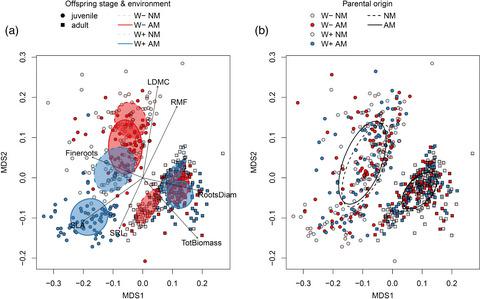Our official English website, www.x-mol.net, welcomes your feedback! (Note: you will need to create a separate account there.)
Mycorrhizal symbiosis alleviates plant water deficit within and across generations via phenotypic plasticity
Journal of Ecology ( IF 5.5 ) Pub Date : 2021-11-05 , DOI: 10.1111/1365-2745.13810 Javier Puy 1, 2 , Carlos P. Carmona 3 , Inga Hiiesalu 3 , Maarja Öpik 3 , Francesco Bello 1, 4 , Mari Moora 3
中文翻译:

菌根共生通过表型可塑性缓解世代内和世代间植物缺水
更新日期:2022-01-13
Journal of Ecology ( IF 5.5 ) Pub Date : 2021-11-05 , DOI: 10.1111/1365-2745.13810 Javier Puy 1, 2 , Carlos P. Carmona 3 , Inga Hiiesalu 3 , Maarja Öpik 3 , Francesco Bello 1, 4 , Mari Moora 3
Affiliation

|
- Phenotypic plasticity is essential for organisms to adapt to local ecological conditions. It is expected that mutualistic interactions, such as arbuscular mycorrhizal (AM) symbiosis, mediate plant phenotypic plasticity, although it is not clear to what extent this plasticity may be heritable (i.e. transgenerational plasticity).
- We tested for plant plasticity within- and across-generations in response to AM symbiosis and varying water availability in a full factorial experiment over two generations, using a genetically uniform line of a perennial apomictic herb, Taraxacum brevicorniculatum. We examined changes in phenotype, performance and AM fungal colonization of the offspring throughout plant development.
- AM symbiosis and water availability triggered phenotypic changes during the life cycle of plants. Additionally, both factors triggered adaptive transgenerational effects especially detectable during the juvenile stage of the offspring. Water deficit and absence of AM fungi caused concordant plant phenotypic modifications towards a ‘stress-coping phenotype’, both within and across generations. Parental environment also affected AM fungal colonization of the offspring. Juvenile offspring of amply watered parents and adut offspring of mycorrhizal parents had increasing length of root colonized by AM fungi when they were under water stress.
- Synthesis. We show that, in addition to providing beneficial transgenerational effects in offspring traits proxies of fitness (such as increased biomass, survival or nutritional status), AM symbiosis can trigger transgenerational plasticity in anatomical and physiological traits related to resource-use acquisition, and further influence offspring AM fungal colonization. Our results show that AM symbiosis could improve plants' ability to cope with environmental stress, not only within, but also across generations.
中文翻译:

菌根共生通过表型可塑性缓解世代内和世代间植物缺水
- 表型可塑性对于生物适应当地生态条件至关重要。预计共生相互作用,如丛枝菌根 (AM) 共生,介导植物表型可塑性,尽管尚不清楚这种可塑性在多大程度上是可遗传的(即跨代可塑性)。
- 我们在两代人的全因子实验中测试了植物在代内和代间的可塑性,以响应 AM 共生和不同的水可用性,使用遗传上一致的多年生无性繁殖草本植物蒲公英。我们检查了整个植物发育过程中后代的表型、性能和 AM 真菌定植的变化。
- AM 共生和水的可用性触发了植物生命周期中的表型变化。此外,这两个因素都引发了适应性跨代效应,尤其是在后代的幼年阶段可以检测到。缺水和 AM 真菌的缺失导致植物表型一致修改为“压力应对表型”,无论是在世代内还是世代之间。亲代环境也影响了后代的 AM 真菌定植。充分浇水的亲本的幼年后代和菌根亲本的成年后代在水分胁迫下被AM真菌定殖的根的长度增加。
- 合成。我们表明,除了在后代的适应性特征(例如增加的生物量、生存或营养状况)中提供有益的跨代效应外,AM 共生还可以触发与资源利用获取相关的解剖和生理特征的跨代可塑性,并进一步影响后代 AM 真菌定植。我们的研究结果表明,AM 共生可以提高植物应对环境压力的能力,不仅在世代内,而且在世代之间。



























 京公网安备 11010802027423号
京公网安备 11010802027423号